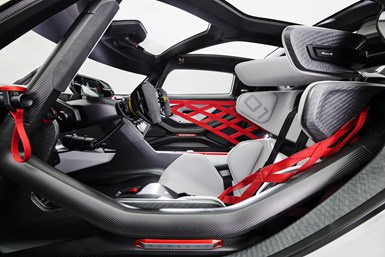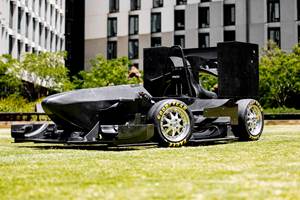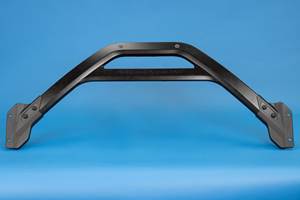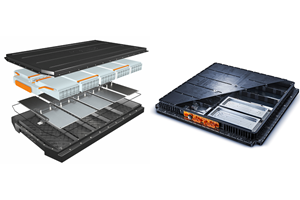Porsche races to the future with electric motors, natural fiber composites
The Mission R concept is Porsche’s vision for sustainable, all-electric customer motorsports, including a CFRP exoskeleton and natural fiber-reinforced components.

The Porsche Mission R concept: An environmentally appropriate race car. The exterior panels are based on flax fiber-reinforced plastics. And the electric vehicle has a top speed of more than 186 mph. Photo Credit, all images: Porsche
Motor racing isn’t exactly the most environmental of activities, given that there are cars and trucks speeding along tracks burning fuel in abundance. As automotive OEMs work to burnish their “green” credentials, the justification of motorsports becomes more difficult.
That is, unless the “motor” isn’t a 2.4-liter direct-injection twin-turbo V6 but electric motors like the Porsche Mission R, which has a 320 kilowatt (kW) motor on the front axle and the 480 kW motor on the rear axle and can go from 0 to 62 miles per hour in 2.5 seconds).
The Mission R is a concept. For now.
When introducing the car at the IAA MOBILITY show in Munich, Germany, Chairman of the Executive Board of Porsche AG Oliver Blume said, “The concept study is our vision of all-electric customer motorsports. The Mission R embodies everything that makes Porsche strong: performance, design and sustainability.”
Michael Mauer, head of Style Porsche, added, “the car is packed to the gills with signs that hint of a future production model, and that, of course, means pure racing!”
But it isn’t just about being an electric car. Porsche plans to be carbon-neutral by 2030, so the Mission E execution is part of its decarbonization approach.

You can see part of the carbon fiber “exoskeleton,” the cage that is the primary structure of the vehicle. The seat shell is produced with natural fiber-reinforced plastic.
To reduce mass while ensuring driver safety, Porsche engineers developed what they call an “exoskeleton,” a carbon fiber-reinforced plastic (CFRP) cage structure. There are six polycarbonate segments around the CFRP cage so that it can be viewed from the exterior and that provide greater visibility for the driver.
A real green play is the use of natural fiber-reinforced plastic (NFRP) for the doors, front and rear wings, sills, side panels and center section. Beyond the exterior, the NFRP is also being used to produce the seat shell.
The fibers being used are flax, which is obtained through a collaboration between the automaker, Federal Ministry of Food and Agriculture (BMEL), the Fraunhofer Institute for Wood Research (Fraunhofer WKI) and material supplier Bcomp (Fribourg, Switzerland). According to Porsche, while the flax is obtained through farming, there is no “conflict with the cultivation of food crops.”
Further, one of the benefits for the ecological checklist is that the production of the fibers occurs with 85% less CO2 than is the case when producing carbon fibers.
Even the tires of Mission R, which were specifically developed for the vehicle by Michelin (Clermont-Ferrand, France), are made entirely with bio-based and renewable materials.
Michael Steiner, member of the Executive Board for Research and Development at Porsche AG notes, “Motorsports of the future will be more electric, more digital and more connected. And it must become more sustainable.”
Yes, they’re going to build it — or something much like it — sooner or later. How could they not?
Related Content
Monash Motorsport constructs FSAE autonomous, electric vehicle with ATL Composites materials
Composite are incorporated into the vehicle’s monocoque chassis, aerofoils, aerofoil endplates and other components to suit high aerodynamic loads, minimize mass and enhance efficiency for the globally competitive team.
Read MoreAutomotive chassis components lighten up with composites
Composite and hybrid components reduce mass, increase functionality on electric and conventional passenger vehicles.
Read MoreTroubleshooting thermal design of composite battery enclosures
Materials, electrical insulation and certification are all important factors to consider when optimizing electric battery performance against potential thermal runaway.
Read MoreMass, cost, durability improvements: EV battery enclosures, Part 2
As interest grows in composite battery covers and trays, composite materials suppliers work to meet current and future needs of automakers, battery module producers.
Read MoreRead Next
From the CW Archives: The tale of the thermoplastic cryotank
In 2006, guest columnist Bob Hartunian related the story of his efforts two decades prior, while at McDonnell Douglas, to develop a thermoplastic composite crytank for hydrogen storage. He learned a lot of lessons.
Read MoreCW’s 2024 Top Shops survey offers new approach to benchmarking
Respondents that complete the survey by April 30, 2024, have the chance to be recognized as an honoree.
Read MoreComposites end markets: Energy (2024)
Composites are used widely in oil/gas, wind and other renewable energy applications. Despite market challenges, growth potential and innovation for composites continue.
Read More
.jpg;width=70;height=70;mode=crop)

























